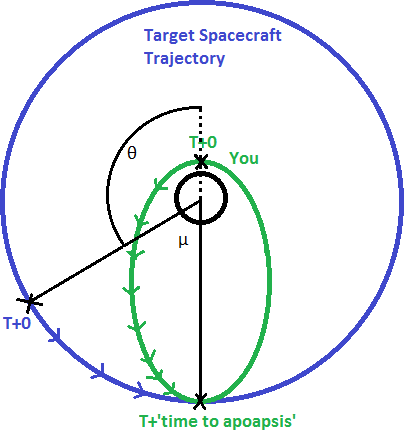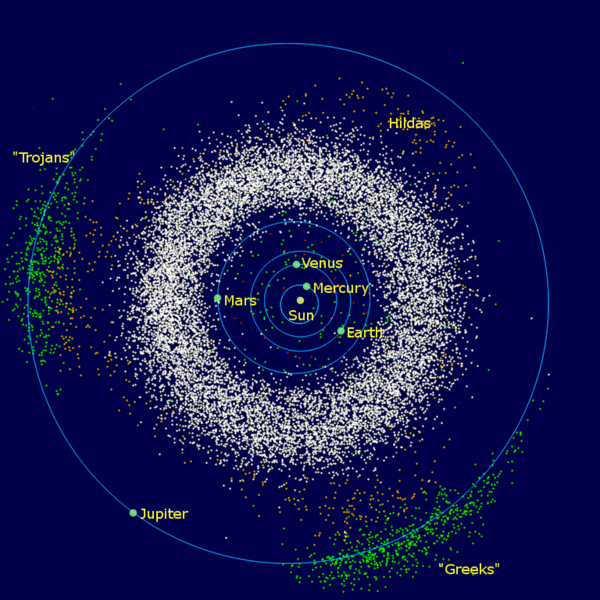Generally speaking, a transfer to the Moon will be very similar to a rendezvous maneuver as discussed earlier, except with the added detail that you have to contend with the Moon's gravity. As a result, this post will be building on the previous postings. What we will discuss here applies to planets that have moons in general, but I will mostly discuss Earth and Luna for the purposes of this post. I will also discuss landing on the Moon to some degree.
In most cases you want to transfer into some kind of orbit around the Moon, from some lower orbit around the Earth. Most moons are on a 'prograde' orbit relative to the planet, they orbit in the same direction as the planets rotation. This means that when you perform an efficient launch as discussed in the first post, you will be orbiting in the same direction as any moons. The significance of this is the fact that you will very rarely have to intercept a moon head-on, and will instead be going in the same direction as them. This reduces the fuel cost of matching speeds with them considerably. Luna is no exception, though interestingly Triton is on a retrograde (opposite of prograde) orbit around Neptune.
Rendezvous with a moon is complicated by a couple of factors. First, a perfectly executed rendezvous would lead to a collision with its surface. Therefore, you need to deliberately miss at least slightly. Second, its gravity will actively mess with your trajectory, especially if it is a big moon like Luna is. This second factor is actually the key to missing the Moon. Lets look at the intercept trajectory diagram from last post.
As far as we can see here, we are pretty much going to smack into the moon as planned. Lets modify the diagram to show how the Moon's gravity is effecting our space craft. The orange vectors indicate this.
You will notice there is a certain net 'leftward' acceleration the moon is imparting on our spacecraft. This will in fact cause it to swing past the Moon when it would have otherwise collided with it. In rough terms, exerting thrust to lengthen or shorten the 'leftward' part your velocity vector will allow you to control your periapsis (minimum altitude) above the Moon. Or in other words, you control the extent to which you miss the Moon. Once you are at your periapsis, you have to decelerate relative to the Moon in order to establish your orbit. This is identical in nature to orbital adjustment maneuvers discussed in the previous post. In general you would want to reduce your speed until you have a circular orbit.
After this point, you may want to attempt a landing. The first step is to decelerate until your trajectory intersects the surface of the Moon. The exact details of this trajectory are relatively unimportant, save the fact that you are de-orbiting yourself somehow and falling into the planet on a ballistic trajectory (you were doing so previously, but now something is in your way). Efficient powered landings bear a certain similarity to the efficient takeoffs discussed in the second post. You in general want to use your engine as little as possible to save fuel, which means slowing down relative to the surface at the absolute last second. This is because you are fighting the Moon's gravity. You could imagine a series of increasingly cautious landings, where you are continuously decelerating to keep your velocity at a comfortable level rather than allowing gravity to continuously speed you up. Eventually you are being so cautious that you are hovering in place, and your landing will take infinite fuel and infinite time. The opposite extreme of this is what is fondly referred to as the 'suicide burn' and is the most efficient landing technique out there. You wait until the absolute last second, then fire your engines at full power to kill all of your velocity just before you reach the surface. Generally missions are a little more cautious than this, because if you start the burn late then you will slam into the surface, generally at traumatically high speeds. Usually powered landings will resemble this in some form or fashion, with very little deceleration until you are close to the surface.
This concept raises the possibility of a relatively interesting landing procedure. When arranging to miss the Moon, instead adjust that leftward velocity vector to zero, deliberately setting a collision course with the Moon. You could at this point conceivably land directly on the Moon via a suicide burn. This general idea has been discussed in the past, and is referred to as a Direct Descent. Unexpected engine failure, or unusually slow engine startup time would most likely be a death sentence for your vessel, so it is generally not seriously considered. I find it to be a fun concept to imagine however, worth trying in Kerbal Space Program if nothing else.
To recap, we discussed transferring from the orbit of a planet to one of its moons. In practice, we used Earth and Luna to discuss this idea. We mentioned the fact that the Moon, as is typical, is on a prograde orbit around the Earth. This makes it cheaper to travel there since its easier to launch spacecraft in a prograde orbit, and it would be harder to transfer to the Moon from a head on approach. We talked about how the Moon's gravity will modify your approach trajectory and generally cause you to miss. We then discussed how you can manipulate this in order to control your altitude once you reach the Moon. Finally, we discussed landing procedures.
In most cases you want to transfer into some kind of orbit around the Moon, from some lower orbit around the Earth. Most moons are on a 'prograde' orbit relative to the planet, they orbit in the same direction as the planets rotation. This means that when you perform an efficient launch as discussed in the first post, you will be orbiting in the same direction as any moons. The significance of this is the fact that you will very rarely have to intercept a moon head-on, and will instead be going in the same direction as them. This reduces the fuel cost of matching speeds with them considerably. Luna is no exception, though interestingly Triton is on a retrograde (opposite of prograde) orbit around Neptune.
Rendezvous with a moon is complicated by a couple of factors. First, a perfectly executed rendezvous would lead to a collision with its surface. Therefore, you need to deliberately miss at least slightly. Second, its gravity will actively mess with your trajectory, especially if it is a big moon like Luna is. This second factor is actually the key to missing the Moon. Lets look at the intercept trajectory diagram from last post.
As far as we can see here, we are pretty much going to smack into the moon as planned. Lets modify the diagram to show how the Moon's gravity is effecting our space craft. The orange vectors indicate this.
You will notice there is a certain net 'leftward' acceleration the moon is imparting on our spacecraft. This will in fact cause it to swing past the Moon when it would have otherwise collided with it. In rough terms, exerting thrust to lengthen or shorten the 'leftward' part your velocity vector will allow you to control your periapsis (minimum altitude) above the Moon. Or in other words, you control the extent to which you miss the Moon. Once you are at your periapsis, you have to decelerate relative to the Moon in order to establish your orbit. This is identical in nature to orbital adjustment maneuvers discussed in the previous post. In general you would want to reduce your speed until you have a circular orbit.
After this point, you may want to attempt a landing. The first step is to decelerate until your trajectory intersects the surface of the Moon. The exact details of this trajectory are relatively unimportant, save the fact that you are de-orbiting yourself somehow and falling into the planet on a ballistic trajectory (you were doing so previously, but now something is in your way). Efficient powered landings bear a certain similarity to the efficient takeoffs discussed in the second post. You in general want to use your engine as little as possible to save fuel, which means slowing down relative to the surface at the absolute last second. This is because you are fighting the Moon's gravity. You could imagine a series of increasingly cautious landings, where you are continuously decelerating to keep your velocity at a comfortable level rather than allowing gravity to continuously speed you up. Eventually you are being so cautious that you are hovering in place, and your landing will take infinite fuel and infinite time. The opposite extreme of this is what is fondly referred to as the 'suicide burn' and is the most efficient landing technique out there. You wait until the absolute last second, then fire your engines at full power to kill all of your velocity just before you reach the surface. Generally missions are a little more cautious than this, because if you start the burn late then you will slam into the surface, generally at traumatically high speeds. Usually powered landings will resemble this in some form or fashion, with very little deceleration until you are close to the surface.
This concept raises the possibility of a relatively interesting landing procedure. When arranging to miss the Moon, instead adjust that leftward velocity vector to zero, deliberately setting a collision course with the Moon. You could at this point conceivably land directly on the Moon via a suicide burn. This general idea has been discussed in the past, and is referred to as a Direct Descent. Unexpected engine failure, or unusually slow engine startup time would most likely be a death sentence for your vessel, so it is generally not seriously considered. I find it to be a fun concept to imagine however, worth trying in Kerbal Space Program if nothing else.
To recap, we discussed transferring from the orbit of a planet to one of its moons. In practice, we used Earth and Luna to discuss this idea. We mentioned the fact that the Moon, as is typical, is on a prograde orbit around the Earth. This makes it cheaper to travel there since its easier to launch spacecraft in a prograde orbit, and it would be harder to transfer to the Moon from a head on approach. We talked about how the Moon's gravity will modify your approach trajectory and generally cause you to miss. We then discussed how you can manipulate this in order to control your altitude once you reach the Moon. Finally, we discussed landing procedures.




